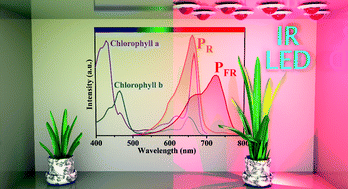Ultra-high-efficiency near-infrared Ga2O3:Cr3+ phosphor and controlling of phytochrome†
Abstract
Phosphor-converted light-emitting diodes (LEDs) have recently become a promising candidate for next-generation devices used in agriculture and horticulture. In principle, they can overcome the limitations of regular daily sunshine. Here, the principle of LED-promoted plant growth was demonstrated by using the Ga2O3:Cr3+ phosphor with an extremely high quantum yield of 92.4%. The detailed structural and luminescent properties were characterized using X-ray diffraction, temperature-dependent photoluminescence, and pressure-dependent photoluminescence. The results reveal the unique two electronic spin-forbidden transition emissions (R1 and R2) of the Ga2O3:Cr3+ phosphor. Plant growth experiments were also conducted to evaluate the practical applications of the as-prepared phosphors, showing that they exhibit obvious positive effects on plants. This work reveals the important role of LEDs in agriculture and horticulture, as well as their potential practical applications.



 Please wait while we load your content...
Please wait while we load your content...